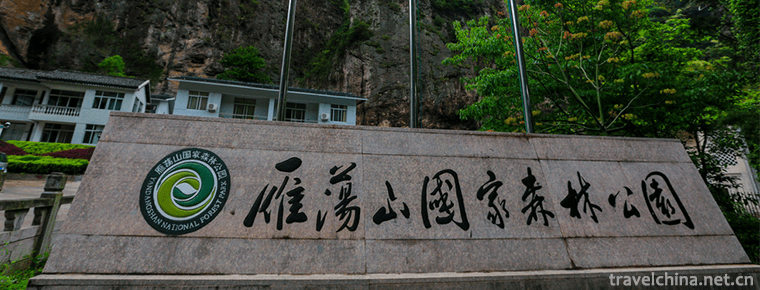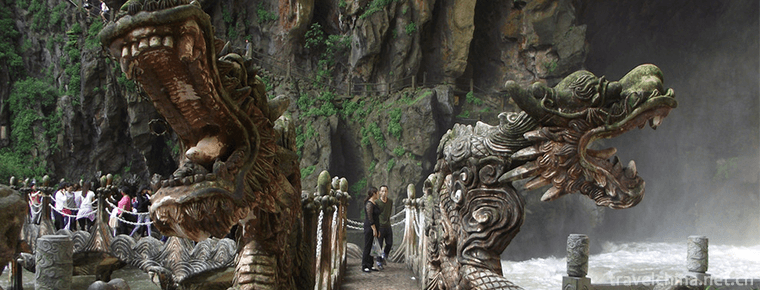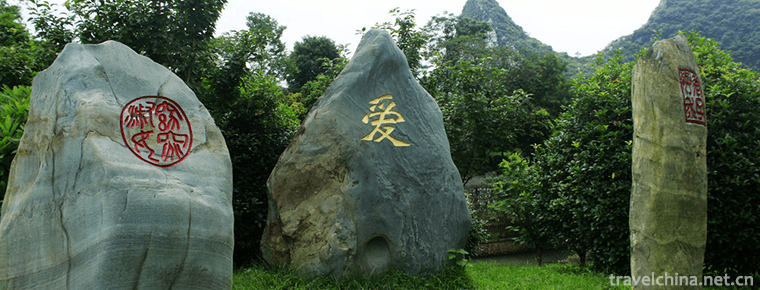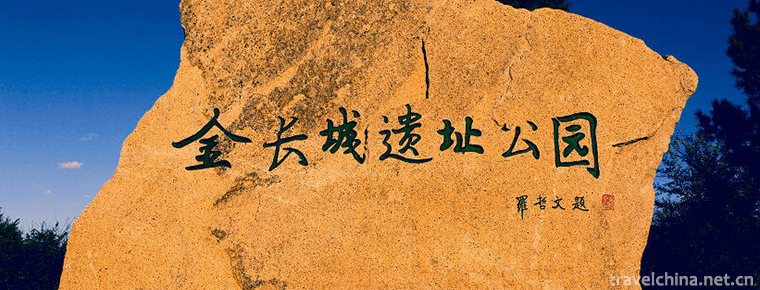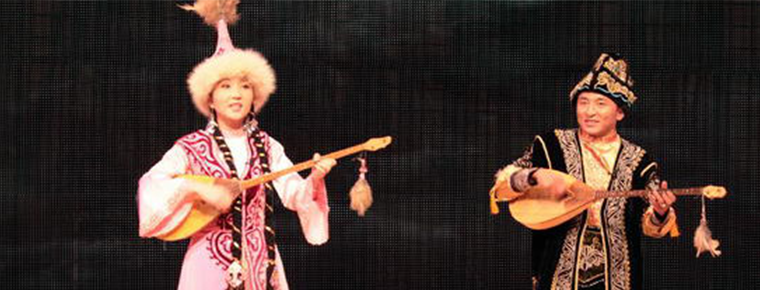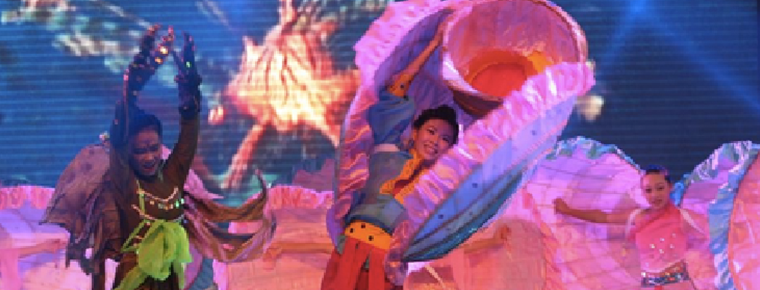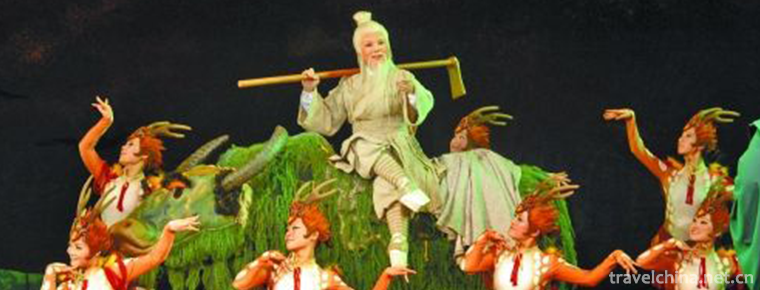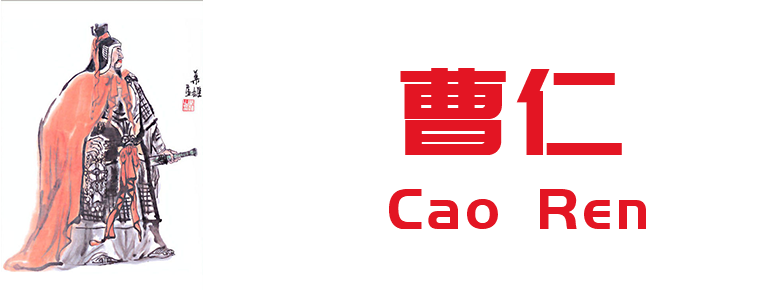Wudang Mountains Scenic Area
Wudang Mountain, the holy place of Taoism in China, is also known as Taihe Mountain, Xieluo Mountain, Shenshan Mountain and Xianshi Mountain. It has been called "Taiyue", "Xuanyue" and "Dayue" in ancient times. It is located in Danjiangkou City, Shiyan City, northwest Hubei Province. Xiangyang City, a famous ancient city in the east, Shiyan City in Checheng City in the west, Shennongjia Primitive Forest in the South and Danjiangkou Reservoir in Pinghu, Gaoxia in the north.
In the Ming Dynasty, Wudang Mountain was named "Dayue" and "Xuanyue" by the emperor, and was honored as "Royal Family Temple". Wudang Mountain is famous for its "crown of the five mountains" status of "all four famous mountains are arched and five immortals and mountains share the emperor's clan".
In December 1994, Wudang Mountain Ancient Architectural Complex was selected into the World Heritage List, and in 2006 it was listed as the "National Key Cultural Relics Protection Unit" . In 2007, Wudang Mountain and the Great Wall, Lijiang, Zhouzhuang and other scenic spots were selected as "ten favorite scenic spots in China by Europeans". From 2010 to 2013, Wudang Mountains were rated as the national 5A tourist area, National Forest park, China's top ten summer resorts, cross-strait exchange base, and the most beautiful "National Geopark".
As of 2013, there are 53 ancient buildings in Wudang Mountain, with an area of 27,000 square meters and 9 building sites, covering an area of more than 200,000 square meters. There are 5,035 cultural relics in the whole mountain.
Wudang Mountain is the birthplace of Taoism and Wudang Wushu. It is known as "the first immortal mountain in the world with unparalleled scenic spots in history". Wudang Wushu is an important school of Chinese Wushu. At the end of Yuan Dynasty and the beginning of Ming Dynasty, Taoist priest Zhang Sanfeng gathered his achievements and founded Wudang School.
The name of "Wudang" first appeared in Han Shu. Han Gaozu five years (202 years ago), located in Wudang County.
From the late Han Dynasty to the Wei, Jin, Sui and Tang Dynasties, it was a place for immortals to learn Taoism.
During the reign of Tang Zhenguan (627 - 649), Emperor Taizong ordered Yao Jian to pray for rain in Wudang Mountain. Build the Five Dragons Temple. During the reign of Qianning (896 - 897), Wudang Mountain ranked ninth in the list of "72 Happy Land".
Since the Tang Dynasty, Wudang Mountain has received the attention of the feudal emperors of all dynasties, named Wudang, making it a noble position and a prominent reputation.
From the Yuan Dynasty to the 22nd year of the Yuan Dynasty (1285), after Zhang Liusun, the Xuan Pope, reported to Kublai Khan, the world's ancestor, Kublai Khan believed in his Tao. Dade eight years (1304), Yuan Chengzong feudal "Wudang Fortune Land".
In the ten years of Yongle in Ming Dynasty (1412), Zhu Di, the founder of Ming Dynasty, ordered Zhangxin Longping Hou, Mu Xin, Lieutenant Duma, Guo Lian, right waiter of Ministry of Works, Jinchun Shangshu of Ministry of Rites, with a rate of more than 200,000 soldiers and civilians, and Wudang Mountain was greatly repaired by craftsmen. Yongle was named "Dayue" in 15th year (1417), which was higher than Wuyue. Yongle 21 years (1423 years), lasted 12 years, 33 large and small palaces in Taihe Mountain were built.
In the 31st year of Jiajing (1552), it was named "Xuanyue for governing the world". It regards Wudang Mountain as the Supreme "imperial temple". It is named "the crown of five mountains" by "all four famous mountains are arched and five Immortal Mountains are all emperors", and it is ranked as the first Taoist mountain in the world. In the 31st year of Jiajing (1552), Lu Jiedi, the right attendant of Shizong's Ministry of Work, restored Wudang Mountain Palace View.
In 1956, the ancient buildings of the whole mountain were listed as key cultural relics protection units in Hubei Province.
In 1961, the Golden Palace was listed as a national key cultural relic protection unit.
On February 22, 1982, the Zixiao Palace was listed as a national key cultural relic protection unit.
In 1983, the State Council listed Taihe Palace and Zixiao Palace in Wudang Mountain as key religious sites in China.
In January 1988, the stone archway of "governing the world and Xuanyue" was listed as a national key cultural relic protection unit.
On December 15, 1996, Nanyan Palace was listed as a national key cultural relic protection unit.
On December 17, 1994, "Wudang Mountain Ancient Architectural Complex" was listed in the World Cultural Heritage List by the United Nations.
In July 2001, the Yuxugong Site was listed as a national key cultural relic protection unit.
In May 2007, the Yuxu Palace renovation project in Wudang Mountain was started.
In 2012, Wudang Mountains launched more than 20 large-scale series of activities in the past 600 years.
On July 25, 2012, the Wulong Palace scenic spot was formally put into development and construction.
On August 1, 2012, the Yuzhengong lifting project was officially launched due to the middle route of South-to-North Water Transfer Project.
On September 27, 2012, the Yuxu Palace in Wudang Mountain was renovated and completed.
Location context
Wudang Mountain is located in Danjiangkou City, Shiyan City, Hubei Province. Xiangyang City, Hubei Province, to the east, Shiyan City, Checheng City to the west, Shennongjia World Natural Heritage Site to the south, and Danjiangkou Reservoir, the source of the South-to-North Water Transfer Project, to the north.
Geographical coordinates are 110 56 15 111 15 23 East longitude, 32 22 30 32 35 06 North latitude, formerly known as "800 square miles", with a total area of 312 square kilometers.
Geology and geomorphology
Mount Wudang is surrounded by peaks, with Tianzhu Peak at an elevation of 1612 meters. Wudang Mountain is surrounded by low, massive protrusions in the center, mostly composed of Paleozoic phyllite, slate and schist, and partly granite. Rock joints are well developed, and there are signs of rising along the old fault line, forming many cliff landforms. There are many subsidence basins on both sides of mountain area, such as Fangxian basin and Yunxian basin.
Climatic characteristics
Wudang Mountain is located in the north subtropical monsoon climate zone, which has the characteristics of North-South transition. From Danjiang Reservoir along the rock to Tianzhu Peak, the vertical climatic zones are obvious, and there are rich and colorful local microclimates. It can be divided into three climatic zones. High-level: Chaotiangong to Jinding, 1200-1612 meters above sea level, annual average temperature 7.7-10.0 degrees C, frost-free period 163-194 days; middle-level: Zixiaogong to Chaotiangong, 750-1200 meters above sea level, annual average humidity 10.0-12.0 degrees C, frost-free period 194-222 days, precipitation 995-1106 mm; Taizipo below 750 meters above sea level In the area of Wudang Mountain Market Town, the annual average temperature is 12.8-16.0 degrees C, the frost-free period is 222-254 days, and the rainfall is 843-995 mm. The reason for the temperature and temperature in the scenic spot is that Wudang Mountain is surrounded by the Qinling Mountains across the river in the East and the Niushan Mountains in the east. The undulating hills in the East slow down the cold air flowing along the Hanjiang River west along the Nanxiang Pass Road, with the adjustment of Han water, so the water area is warm in winter and cool in summer.
Main attractions
Wudang Mountain has 72 peaks, 36 rocks, 24 streams, 11 caves, Santan, Jiuquan, Shichi, Jiujing, Shishi, Jiutai and other scenic spots. The scenic spots are centered around Tianzhu Peak, with dangerous roads such as the upper and lower eighteen pans, and "the summit of the seventy-second peak dynasty" and "the overlap of the golden palace".
The Palace of Supreme Harmony
Taihe Palace is located in the south side of Tianzhu Peak, covering an area of 80,000 square meters, with more than 20 ancient buildings, with an area of more than 1,600 square meters . The whole building is situated on a solitary peak and steep ridge. The palace building is near the mountain and rocks with exquisite structure. It is the highest scenic spot of Wudang Mountain. No matter Taoist priests or pilgrims, only by climbing the peak and entering the Taihe Palace can we reach Wudang Mountain in a real sense. In the 10th year of Yongle Ming Dynasty (1412), Zhu Di, the ancestor of Ming Chengzu, ordered the Taihe Palace to be built. After the completion of the palace, Mount Wudang of Jiafeng became "Taihe Mountain of Dayue", and the Tao Palace on the top was "Taihe Palace of Dayue".
Golden Hall
The Golden Palace is located on Xiaolian Peak in front of Tianzhu Peak. In the eleventh year of the Yuan Dynasty (1307), Dadi was cast with a height of 3 meters, a width of 2.8 meters, a depth of 2.4 meters, and a suspended hill roof. All the components were cast in pieces, mortise and tenon assemblies. All the castings were marked with the installation parts. The lattice fan skirt plate was cast with the words "This hall was cast in the eleventh year of the Yuan Dynasty in Meiting Wanshi Workshop of Wuchang", which is the earliest copper cast wood in China. Structural architecture.
The Forbidden City
The Forbidden City was built in Yongle 17 years (1419), surrounded by Yantianzhu Peak, 345 meters in circumference, 2.4 meters in thickness, 1.8 meters in thickness, and 10 meters in the highest part of the wall. Each stone weighs more than 500 kilograms. According to the model of Chinese paradise, there are four stone-carved wooden-like buildings in the east, south, West and north, which symbolize the Tianmen. The stone sculpture is built on the cliff wall, which is skillfully designed and difficult to construct. It is the product of the combination of science and art in Ming Dynasty.
Jingle Palace
Jingle Palace is the first of the Eight Palaces in Wudang Mountain. It was built in Yongle Mountain in Ming Dynasty in eleven years. Because it was submerged in the reservoir when the Danjiangkou Reservoir was built in 1958, a number of cultural relics such as the archway in the palace and the tablet of tortoise pipes were moved to Danjiangkou. In 2002, the city of Danjiangkou introduced 70 million yuan of capital and implemented the restoration of Jingle Palace in an all-round way. After more than two years of construction, the first phase of the project, such as the square, the mountain gate, the imperial stele pavilion, the three halls and the matching palace, has taken shape, reproducing the grand momentum of Jingle Palace in that year, and has become an example of the relocation and restoration of cultural relics on the ground of the South-to-North Water Transfer Project of Danjiangkou
The Portal of Entry
Xuanyue Gate is commonly known as the "Xuanyue" archway, which is a stone building with three four columns and five floors. The archway of "governing Xuanyue" was built in the 31st year of Jiajing in Ming Dynasty (1552). Located 4000 meters east of Wudang Mountain Town, it is the first gateway to Wudang Mountain, also known as Xuanyue Gate.
Jade Void Palace
Yuxu Palace is called "Xuan Tian Yuxu Palace". Built in the eleventh year of Yongle in the Ming Dynasty (1413), 2200 temples and temples were built. Jiajing was renovated in 31 years. It is the largest unit in the ancient building complex of Wudang Mountain. Later, most of them were destroyed in the decade of Qianlong in the Qing Dynasty (1745). Some of the existing buildings and sites were also built with four Pavilions weighing up to 100 tons.
Grinding well
Grinding needle well is also known as Chunyang Palace. Located 12 kilometers south of Laoying, it was built in Yongle of Ming Dynasty. The existing needle-grinding well was rebuilt in 1852. In 1984, it was repaired as before. There were more than 50 chambers with an area of 1700 square meters.
Taizi slope
Taizipo is also known as Fuzhenguan. Maintaining the current scale is a large unit in Wudang Architectural Complex. Founded in the Ming Yongle Decade (1412), the Fuzhen View was rebuilt in the Qing Emperor Kangxi's 22nd year (1683). Located in front of Lion Peak, there are 20 buildings with an area of 3505 square meters and an area of 60,000 square meters.
Nan Yan
Nanyan is the holy land of Zhenwu Dedao, which is called by Taoism. It is the most beautiful place in the 36 rocks of Wudang Mountain. Nanyan Palace was built from the 22nd to the 13th year of the Yuan Dynasty (1285-1310), and expanded in the 10th year of Yongle in the Ming Dynasty (1412). Located under the Duyang Rock, the mountains are flying like wings hanging from the sky. They are famous for their beautiful peaks and mountains. Existing 21 buildings, building area of 3505 square meters, covering 90,000 square meters. There are bills for Tianyi Zhenqing Palace, Shi Palace, Liangyi Palace, Huangjing Hall, Bafeng Pavilion, Dragon and Tiger Palace, Dabei Pavilion and Nantianmen Building. The main building, Tianyi Zhenqing Palace and Stone Palace, was built between the Yuan Dynasty and the third year (1310 years). It is 11 meters wide, 6.6 meters deep and 6.8 meters high. The beams, columns, doors and windows are all carved in blue stone. The front slope of the top is of single eaves and hills, and the back slope is of rock type. It is made of suspended hills. The bucket under the eaves is made of two jumps, which is the practice of building bucket in Liao and Jin Dynasties. Leading incense, 3 meters long and 0.33 meters wide, is picked out from across the sky, facing deep valleys. A small incense burner is placed on the tap, which is extremely dangerous and has high artistry and science.
Qiong Tai view
Qiongtai View is located at the southeast foot of Tianzhu Peak about 10 kilometers, with a vertical distance of 1350 meters. It can be divided into upper view, middle view and lower view. In the Yuan Dynasty, it was called Qiongtai Palace. During the Ming and Qing Dynasties, 24 monasteries and hundreds of temples were renovated and expanded. By the sixth year of Xianfeng in Qing Dynasty (1856), it was destroyed by fire and arms. Some Temple houses have been repaired. This section is the starting point of Wudang Mountain passenger ropeway. It has become an important tourist distribution center.
Hidden fairy rock
Located above Zhuguan and north of Wulong Palace, Crypto-immortal Rock is a large cave in the 36 rocks of Wudang Mountain. It is about 15 meters long and about 1.5 meters deep. The cave rocks are composed of chlorite albite schist, sericite quartz albite schist and shallow granulite. After intense compression, the rocks form complex fold patterns, forming a broad and gentle back-shaped structure as a whole. These complex patterns are the product of shear stress during the 210 million years or so. Caves are formed by weathering and caving of rocks along fragile flake rocks.
Wu Zhu Feng
Wuzhu Peak is located in Muomagou Village, Guanshan Town, Danjiangkou City, Shiyan City, Hubei Province. It is also called Daming Peak and Stigma Rock. Zhenwu Sitting Statue (named after Zhenwu Emperor's father, Jingle Kingdom, Mingzhen Emperor) was built in Yuan Dynasty. It is 14 kilometers away from Wutian Zhufeng, one of the 72 peaks in Wudang, with an elevation of 1132 meters. This seat resembles a bamboo shoot-shaped seat with a natural stone statue about 80 meters high and 40 meters wide between them, which resembles the real Wu Emperor statue at Jinding, Wudang Mountains.
Historical culture
Wudang Taoism
Wudang Taoism is an important school of Taoism in China. It is a Taoist sect that takes Wudang Mountain as its base, believes in Zhenwu-basalt, attaches importance to Neidan practice, is good at Leifa and Fuyu, and emphasizes the integration of loyalty, filial piety and three religions. Zhenwu, namely Yuanwu, is also known as Xuanwu because of its connection with Yuanwu. Zhao Heng of Song Zhenzong changed Xuanwu into Zhenwu and revered it as "Blessing the Saint Emperor". According to "Zhenwu Ben Zhuan Shen Jia Miao Jing", Xuanwu is the 82 incarnation of Laojun Taishang. After 42 years of practice in Wudang Mountain, he has succeeded in fulfilling Tao and ascending to heaven to become God. He was named "Xuan Tian Di" by the Jade Emperor and guarded the north. Therefore, Wudang Mountain is respected by Taoism as the holy place for the cultivation of Xuan Tianwu God.
From the Spring and Autumn Period to the end of the Han Dynasty, Mount Wudang was an important place for religious activities in ancient times. Many dignitaries came here to practice. Such as: Dr. Zhou Yinxi, General Dai Meng of Emperor Wudi of Han Dynasty, famous alchemist Ma Mingsheng and Yin Changsheng once concealed this mountain for practice. After the birth of Taoism in the late Eastern Han Dynasty, Wudang Mountain gradually became the center of Taoist activities in Central Plains.
From the end of the Han Dynasty to the Southern and Northern Dynasties, due to social unrest, hundreds of scholar-bureaucrats either resigned or abandoned their homes, gathered in Wudang to open up Valley monastery. At the same time, there are books about Zhenwu. Xie Yun, Xu Ziping of Jin Dynasty and Liu Qi of Southern and Northern Dynasties all abandoned their officials and went to the mountains to practice. The Oath Note was honored by Buddhism as Huisi, one of the three ancestors of Tiantai Zong. He visited Wudang Mountain in the Six Dynasties. In Shenxianjian, Zhuge Liang, Shuhan Military Master, once went to Wudang Mountain to learn Taoism.
During the Sui and Tang Dynasties, Wudang Taoism was highly respected by feudal emperors, which promoted the development of Wudang Taoism. Li Tang claimed to be the descendant of Lao Tzu. He believed that Lao Tzu was the ancestor of Li Tang. He supported and respected Taoism and made it the first of the three religions. What made Wudang Taoism valued by the royal family was Yao Jian. During the period of Tang Zhenguan, there was a great drought in the world and locusts were everywhere. The emperor ordered the world famous mountains and rivers without any response. The Wudang Festival made Yao Jianfeng pray for rain in Wudang Mountain and build Wulong Temple, which was the first temple built by the emperor in Wudang Mountain. At this time, many famous highways lived in seclusion in Wudang Mountain, such as Yao Jian, Sun Simiao, Tao Youan, Lu Dongbin and so on. At the end of Tang Dynasty, Wudang Mountain was listed as the ninth blessed place among the 72 blessed places of Taoism. During the Song and Yuan Dynasties, because the feudal rulers strongly respected and propagated Wudang Zhenwu God, the status of the God of Zhenwu God was constantly improved, and the formation of Wudang Taoism and its influence on society were expanding. Song Zhenzong was named "Zhenwu Ling Yingzhenjun" in the second year of Tianxi (1018). He worshipped the statues of the ancestral halls and promoted the Wulong Temple to a high level. Song Renzong advocated Zhenwu as the "god of the family of the community" and built the statue of Zhenwu Temple to worship. Huizong, Ningzong and Lizong are all titles of Zhenwu and devout worship. Famous Taoist monks such as Deng Ruozhuo, Chancellor Xu, Thank Heaven and Earth, Sun Jingran and so on entered the mountain to propagate Taoism, which further developed Wudang Taoism.
During the Yuan Dynasty, Taoism was greatly favored by the rulers of the Yuan Dynasty. Wudang Mountain became an important Taoist venue for the emperor of the Yuan Dynasty to celebrate his birthday, and Wudang Taoism was fully developed. Among the people, there are a lot of incense believers who go to the mountains, and the incense is very strong. "On March 3, tens of thousands of Zhenwu Women's Club of Christmas Scholars, Golden Silk Shi, Yunweichuan to go." With the rapid development of Taoist organizations, such as Wang Zhenchang, Ye Yunlai and Zhang Shouqing, the social influence of Wudang Taoism is increasing. Wudang Mountain has become a Taoist holy place with the same name as Longhu Mountain of Tianshi Taoism.
In the Ming Dynasty, Wudang Mountain was always supported by emperors of all dynasties as "imperial temples" and worshipped as "national gods". Wudang Mountain's status was sublimated to "the world's first immortal mountain" and above the five mountains. It became the center of Taoist activities in the country, presenting a prosperous situation for more than 200 years. Zhu Yuanzhang, the Taizu of the Ming Dynasty, worshipped Zhenwu God, which laid the foundation for the descendants to worship Zhenwu God. The emperor who pushed Wudang Taoism to prosperity was Zhu Di, the ancestor of Ming Chengzu. Zhu Di, the fourth son of Zhu Yuanzhang, was the first king of Yan, who was in Beijing and guarded the north. After Zhu Yuanzhang's death, his eldest grandson Zhu Yunzhang succeeded.
In
the name of "Qingjun side", Zhu Di thrived on "Jing Nan's
Teacher" and seized the power of his nephew Zhu Yunzhong at one stroke. In
order to consolidate the regime, Zhu Ding claimed that Zhenwu had blessed him
and his father to win the world. In order to repay God's grace, he repaired Hou
Zhangxin, Lieutenant Ma Duxin, Jin Chun of the Ministry of Rites and Guo Lian,
the right attendant of the Ministry of Engineering, to build nine palaces and
nine temples on the old site of the Yuan Dynasty. After becoming ancestors, the
emperors, princes and nobles, local officials and Sifang believers of the Ming
Dynasty built and expanded temples here. In the 31st year of Jiajing (1552),
Emperor Zhu Houyu of Ming Dynasty sent his ministers and led Huguang army and
civilians to carry out large-scale reconstruction and expansion in Wudang
Mountain, which made the view of Wudang Taoist Palace unprecedentedly grand.
The emperor of the Ming Dynasty ruled Wudang Tao directly. From his ancestors,
all dynasties sent his ministers (eunuchs) and vassals to supervise all the
affairs of Wudang Mountain and were directly responsible to the Royal family.
Chengzu selected 400 Taoist monks from all over the country to run Taoism in
Wudang Mountains, and 23 Taoist monks of high moral standing from them were
awarded six points to manage the major palaces and spectacles concretely. At
the same time, we rewarded Taoism with several hundred miles of Wudang Mountain
farm and transferred 555 prisoners to cultivate for Taoist priests. During the
period from Yongle to Longqing (1403-1572), 22 ministers and 48 vassals were
sent to live in the mountains and appointed governors. 191 nominations were
awarded to them, who were in charge of the palaces. By the time of Jiajing
(1522-1566), there were three or four hundred Taoists, more than five or six
hundred, and more than ten thousand Taoist officials, Taoists, army and
craftsmen. There is an endless flow of people in Wudang dynasty. Zhang Kaidong
in the Ming Dynasty described his prosperity in Dayue Fu: "The heel
millstone wears, the sound of mountain cracks." We can see the prosperity
at that time.
The rulers of Qing Dynasty paid more attention to Buddhism and less to Taoism. Therefore, Wudang Taoism was declining day by day. But among the people, the incense-entering activities of believers from all over the country to Wudang Mountain are still very prosperous. During the Republic of China, the local government of the Kuomintang was prepared to develop Wudang Mountain, but because of the state turmoil and insufficient funds, Wudang Mountain declined even more. Before liberation, there were ruins of broken temples everywhere. With the decline of church organizations, religious activities almost stopped.
Since the founding of New China, the Chang and the government have pursued the policy of "freedom of religious belief", and Wudang Taoism has undergone great changes. The Taoists resumed the religious activities of the political parties. Especially after the reform and opening-up, Wudang Taoist Association has formulated the Constitution of Wudang Mountain Taoist Association and the management system of various palaces. The State Council has put the Zixiao Palace and Taihe Palace under the management of Wudang Mountain Taoist Association and opened them to the outside world as key places of religious activities. In 1997, the Hubei Provincial Government put Wulong Palace, Qingwei Palace and Qiongtaizhong Palace into operation. Wudang Mountain Road Association for Management. Taoist activities are well organized. Wudang Taoists also have a certain position in politics. The head of Wudang Mountain Road Association has been elected as vice-chairman of Danjiangkou City and Shiyan Municipal Consultative Conference, Standing Committee of Hubei CPPCC and member of the CPPCC National Committee. Since the establishment of Wudang Mountain Road Association, tens of millions of yuan have been invested in the large-scale maintenance of ancient buildings such as Taihe Palace, Zixiao Hall, imperial stele pavilion, Yujichi Pool and Qiongtai Zhongguan, which has brought about a new look. Strengthen the excavation, collation and research of Taoist culture. In September 1992, the International Symposium on Chinese Wudang Taoist Culture was successfully held. At the same time, Taoist cultural exchanges and Wudang Wushu exchanges with Italy, Singapore, Thailand and Malaysia, as well as Taoist organizations in Taiwan, Hong Kong and Macao, have been carried out to expand the influence of Wudang Taoism at home and abroad, and to push Wudang Taoist culture to a new stage of development.
Wudang ancient building
Wudang Ancient Architecture can be traced back to Qin and Han Dynasty, where many hermits and Taoists formed Mao temples. During the reign of Zhenguan in the Tang Dynasty (627-649), Emperor Taizong of the Tang Dynasty built the Five Dragons Temple; during the Great calendar years (766-779), temples such as Taiyi and Yanchang were built; and in the third year of Qianning (896), a new temple of Shenwei Wugong was built.
The Five Dragons Temple was promoted to the Five Dragons Temple in Song Zhenzong, and the Purple Xiaogong Palace was founded in the reign of Song Xuanhe (1119-1125). The Yuan Dynasty built 9 palaces and 8 temples.
During the Yongle reign of Ming Dynasty, Emperor Yongle sent Longping to wait for Zhang Xin, Lieutenant Kumadu Muxin, Minister of Rites Lang Jinchun, and Ministry of Works right waiter Guo Lian to lead more than 300,000 military and civilian craftsmen. In 12 years, 33 buildings including 9 palaces and 9 views were built on the 160-mile-long construction line of Wudang Mountain. During Chenghua and Jiajing years, Wudang Mountain was expanded and expanded, making it the largest Pagoda in the country at that time. According to incomplete statistics, there were more than 500 buildings in the Ming Dynasty, the size of which was more than 20,000.
From the Qing Dynasty to the Republic of China, buildings in Wudang Mountain were destroyed, destroyed or collapsed.
After liberation, the Party and the government took a series of measures to protect the ancient buildings in Wudang Mountain. The government of Hubei Province has listed the ancient buildings in the whole mountain as the key cultural relics protection units of the whole province, and the Jindian, Zixiaogong, Shi Memorial archway, Nanyan Palace and Yuxugong sites have been listed as the key cultural relics protection units of the state. The state has allocated special funds to repair and rebuild more than 200 buildings and more than 30,000 square meters, and to repair three ancient mountain-climbing shrines and more than a dozen ancient bridges. Existing 129 relatively intact buildings, 1182 temple houses, building area of 43,332 square meters, is still the grand momentum of that year.
The
ancient buildings in Wudang Mountain are designed according to the myth of
Zhenwu Xiuzhen in Zhenwu Jing, which highlights the theme of Zhenwu belief. In
Zhenwu Jing, the birthplace of Zhenwu is Jingyue Kingdom, so there are Jingyue
Palace built outside the city of Junzhou; Wulong, Zixiao and Nanyan are places
for Zhenwu practice; Yuxu Palace is named after Zhenwu as "the truth of
Yuxu Master"; Zhenwu Zengyuan and Zhenwu Jianhe Guan by relocating school
officials; Huilongguan, Huixin Temple, Mojianjing, Prince. Poe, Longquan View,
Upper and Lower Eighteen Pans, Tianjin Bridge and Jiududujian all have
something to do with the myth of Zhenwu Xiuzhen. They create a strong religious
atmosphere. Once Chaoshan pilgrims enter Mount Wudang, they immerse themselves
in the myth atmosphere of Zhenwu Xiuzhen and deepen their belief and respect
for Zhenwu imperceptibly.
The overall layout of the ancient buildings in Wudang Mountain is centered on Tianzhufeng Golden Palace and radiates around the official road and ancient Shendao along the axis. It is 80 kilometers from the north to the stone archway beside the Xiangshui River, 25 kilometers from the south to the Youshengguan Temple on the Yanchi River, 50 kilometers from the west to the Bailang Heilong Temple and 35 kilometers from the east to the Jieshan Temple. With the unified design and layout of the Royal Architecture, the whole building complex is large in scale, prominent in theme and orderly. The ancient buildings of Wudang Mountain also embody the Taoist idea of "advocating nature" and maintain the primitive natural features of Wudang Mountain. The craftsmen designed the layout according to the principles of Zhu Di, the ancestor of Ming Chengzu, that is "wide and narrow", "defining its rules" and "never modifying its mountains". The materials for building Wudang Mountain are not local materials, but from Shaanxi, Sichuan and other places. During the construction, we should make full use of the majesty of the peaks and the cragginess and seclusion of the rock streams, so that each building unit can be built at the appropriate location of the peaks, mountains, rocks and streams. The spacing and size of the building are arranged appropriately, so that the building and the surrounding environment can be integrated organically, and when it comes to the time, it appears, if it is bright or dark, if it is mixed. The artistic effect of integration.
Looking at the ancient buildings of Wudang Mountain, it gathers the excellent architectural styles of ancient China. It embodies the magnificent and magnificent imperial palace, the mysterious and mysterious Taoism, the quiet and elegant gardens, the simplicity and frugality of the folk and other characteristics, and forms a rich and colorful traditional architectural style. Zhang Kaidong of the Ming Dynasty called Wudang Mountain's architecture "the remnants of the Qin Emperor and the Han Dynasty, which were rare in previous dynasties, and the victory of Zhang Jinque's Lin Palace was nothing in the world".
In 1982, when the State Council announced Wudang Mountain as a key scenic spot, it said that the ancient buildings of Wudang Mountain were "vast in engineering and exquisite in craftsmanship, which successfully embodied the artistic conception of"Qiongge in Xianshan Mountain", just like an exhibition of the achievements of ancient architecture in China.
On December 17, 1994, it was listed in the World Cultural Heritage List by UNESCO.
Wudang Martial Arts
Wudang Wushu is a treasure of Chinese Wushu, known as "North Chong Shaolin, South Zun Wudang".
Wudang Wushu and Wudang Taoism have deep roots. When practicing Taoism, Wudang Taoists often practice martial arts with them. Before the Song Dynasty, Wudang Taoist priests had outstanding martial arts masters. At the end of Yuan Dynasty and the beginning of Ming Dynasty, Wudang Taoist monk Zhang Sanfeng set up Wudang Neijia Quan, which was respected as the founder of Wudang Wushu and laid a foundation for its development. Because Wudang Wushu is influenced by the tradition of Taoist secret biography, Wudang Wushu has been hidden for a long time. From the Qing Dynasty to the Republic of China, due to social unrest and the decline of Taoism, many Taoists returned from the mountains and became vulgar. Wudang Wushu was spread among the people.
On the basis of inheriting the theory of attack and defense of ancient Wushu, Wudang Wushu has gradually formed its own theoretical system and unique routine style by applying some principles in Yi and taking the experience of Neidan Gongfu in Taoism as reference. Its theoretical core is the rise and fall of Yin and Yang, the evolution of Eight Diagrams and the birth of Five Elements. It aims at training and self-defense and health care. It has the intention and strength to influence four or two sets of kilograms. It uses flexibility to overcome rigidity, and then produces people. It is located in an inch, so as to control the enemy against capture and closure.
Wudang Wushu includes Taijiquan, Xingyiquan, Bagua palm, Wudang Qigong, Wudang sword and other boxing techniques and instruments. It has formed many kinds of boxing in the long-term development process, such as Neijia Quan, Wudang Taiyi Wuxing Quan, Wudang Chunyang Quan, Wudang Dan School Swordsmanship, Zhaobao Taijiquan, Chen-style Taijiquan, Yang-style Taijiquan, Wushu Taijiquan, Sun-style Taijiquan, Gongjia Southern School and so on.
In order to promote Wudang Wushu, in 1982, Danjiangkou City established the Wudang Mountain Wudang Boxing Research Association and founded the magazine Wudang. In March 2003, the Wudang Association of Shiyan City was established. Digging and sorting out more than 150 routines of boxing, sword, knife and qigong. In Wudang Mountains, Wudang Wushu has been listed as a compulsory course in primary and secondary schools, and more than a dozen Wushu academies, schools and gymnasiums have been set up, as well as Wushu training courses, to train the successors of Wushu. In Wudang Mountains, Wudang Culture Wushu Festival, Wudang Wushu Taiwanese Competition, Wudang International Exchange Conference and Wudang Kungfu Gonggong Seminar were successfully held to promote Wudang Wushu. There are dozens of Wudang Wushu research institutes, millions of people practicing Wudang Wushu at home and abroad. Many amateurs from the United States, Canada, Britain, France, Singapore, Japan and other countries and regions come to Wudang Mountain to study Wudang Wushu. In 1996, Wudang Mountain was listed as "the country of Wushu".
Taoist Music
Wudang Taoist music is an important part of Chinese Taoist music culture, referred to as Wudang Taoist music. It inherits the ancient tradition of witchcraft dance music and absorbs the essence of folk music, court music and folk music in the pre-Qin period. According to the unique aesthetic taste of Taoism, it is integrated and reformed, forming a unique Taoist music, which has the function of rendering law events and setting off religious atmosphere, and runs through all aspects. Legal activities are always carried out.
Wudang Taoist music came into being earlier. In the Eastern Han Dynasty, the Taoist Taiping Sutra believed that music could touch the world, connect gods and tranquilize the people. In the Eastern Jin Dynasty, the "Yuan Shi Wu Du Ren Jing" thought that the divorce of Sanskrit Qi made a sound, and this natural sound was the implicit language of the Sanskrit. In this way, Taoist music became the language of God and gave it sacredness. In the Northern and Southern Dynasties, Kou Qianzhi, a Taoist scholar in the Northern Wei Dynasty, changed his direct recitation to music recitation, combining recitation of scriptures with music to foil and foil each other. Lu Xiujing, a Taoist priest in Liu and Song dynasties in the Southern Dynasty, absorbed Confucian rituals and laws, formulated rituals of Zhai Dun, and gradually standardized them. In the Tang and Song Dynasties, it had begun to take shape. In Tang Dynasty, court music spread to Wudang Mountain. Chen Xuan, a famous Taoist monk in Wudang of the Five Dynasties, was well versed in classics and had a high musical accomplishment. In the Southern Song Dynasty, Wudang Taoist priest Sun Zengran was ordered to enter the palace and set up a Taoist ceremony. In the Yuan Dynasty, because emperors of all dynasties respected Zhenwu God, every year the birthday of Zhenwu, Tianshou Festival and the birthday of the emperor, the royal family sent directly to Mount Wudang to build bamboo pottery, which made the Taoist music of Mount Wudang develop.
The Ming Dynasty was the most brilliant period for the development of Wudang Taoist music. Because Wudang Taoism was highly praised by Zhu Di, the ancestor of Ming Chengzu, and built Wudang, Wudang Mountain became a "royal family temple". Zhu Di also wrote "Daming Imperial Xuanjiao Movement" for Wudang Taoists to sing, and selected more than 400 highways from all parts of the country and sent them to Wudang Mountains'palaces to observe Taoism; sacrifices were also set up as "music" according to the court system. Dance students (those who have been trained in court sacrificial music for imperial performance, chanting sutras and playing music) often set up altars in Wudang Mountain for three or seven days at a minimum and for forty-nine days at a long time. "In such grand national sacrificial ceremonies, Taoist music has a huge lineup, not only employing hundreds of Taoist priests in this mountain, but also conscribing Taoist priests from all parts of the country to assist them." In Wudang Mountains, the Royal band was selected to strengthen its prestige, and a scene of "celestial music spreading from the outside world" and "celestial music floating everywhere" was formed. In this way, Wudang Dao music is constantly improving and maturing. From the Qing Dynasty to the Republic of China, because Taoism was not officially valued, Taoists either fled or returned to the popular world, there were not many people who played classical music, "Wudang Taoist music, which was very popular for a time, almost died out."
After liberation, the Party and the government excavated and sorted out Wudang Dao Music. Especially after the Third Plenary Session of the Eleventh Central Committee of the Communist Party of China, in order to preserve the cultural heritage on the verge of loss, the Hubei Provincial Department of Culture and the Bureau of Ethnic and Religious Affairs organized experts from Wuhan Conservatory of Music from 1986 to 1987 to collect and arrange six times at Zixiao Palace and Taihe Palace, and published the book "Taoist Music of Wudang Mountain in China", which is the first book. A monograph on Chinese Taoist music. At the same time, the Taoist Association invited Wuhan Conservatory of Music to organize Taoist music classes to train more than 20 Taoist music talents for Wudang Mountain, which greatly improved the level of Taoist music. In 1987, a concert of Chinese folk instrumental music and religious temples was held in Wudang Mountain. The experts at the concert fully affirmed the Taoist music of Wudang Mountain and considered it a valuable heritage of our country. On May 26, 1999, when Jiang Zemin visited Wudang Mountain, he praised Wudang Taoist music as "Chinese immortal music is charming, beautiful, edifying sentiment and giving people great enjoyment".
Wudang Dao music is an art form of "singing and dancing music" as a whole, which can be divided into "rhyme tune" and "qu pai". According to the different singing occasions and objects, the rhyme can be divided into Yang and Yin tones, and the tunes can be divided into the right tune and the playing tune. Yang Diao is mainly used in Temple sacrificial ceremonies, in conjunction with recitation and performance. Its object is "God", and it is a song used in religious internal activities. Yin tone, which is used in the activities of Zhai Tao field outside the temple, is a song used in the activities outside the religion. Orthodox, used to do things for gods. Playing music is mainly used to do Tao for the vulgar people. There are bells, drums, gongs, cymbals, cymbals, big wooden fish, sheng, xiao, pipes, flutes and so on.
Wudang Taoist music not only has the common characteristics of Chinese Taoist music, but also has its unique personality characteristics. According to the Records of Mount Wudang, it has four characteristics:
First, solemn and elegant temperament. From Tang Dynasty to Ming Dynasty, Wudang Dao was attached great importance to by the Royal family. In Wudang Mountains, gods and rituals were placed, music and dancers were allocated, which was included in the agenda of the Royal government. The court elegant music had a great influence on Wudang Dao music, so it had a solemn and elegant temperament of court music.
Second, the unique religious charm of blending. Taoist priests of the genuine and first-class factions in Wudang Mountain have long been singing and satirizing scriptures and music in the same room, absorbing and penetrating each other, thus forming a rich and colorful and coordinated charm of Wudang immortal music.
Third, the local characteristics of the blending of North and South. Wudang Mountain is adjacent to Sichuan, Shaanxi and Henan, where folk songs, operas and operas are abundant, and Wudang Dao music is influenced by them. Moreover, the royal family has chosen more than 400 highways from all over the country to run Wudang Mountain, and Taoists from other places often travel to Wudang Jungle by hanging lists, all of which have a certain impact on the development of Dao music.
Fourthly, Wudang Taoist music also integrates and absorbs a considerable number of Buddhist cultural factors, so it has a religious style of Taoist-Buddhist integration.
The Wudang Mountain Taoist Association and the tourism department have recorded and published tapes such as Wudang Xianyun, Wudang Taoist Music in China, Wudang Taoist Morning and Evening Tables, and made and broadcast TV feature films such as Taihe Xuanyue and Wudang Charm. Along the ancient Shendao from Wudang Mountain to Jinding, a terrestrial loudspeaker was installed to play Wudang Taoist music. Tourists can enjoy Wudang Taoist music with unique charm at any time during the tour.
Health care in Wudang County
Wudang Neijiaquan attaches great importance to health preservation and regards skilled fighting as a by-product of health preservation (i.e. playing a skilled fighting role without violating the principle of health preservation). Even if it's fighting, it reflects that nobility is not expensive and strength is exerted by force. It emphasizes innate intuition and inspiration in consciousness and internal strength in strength. Therefore, Neijiaquan generally reflects a soft, neutral and gentle line of boxing posture. So some people say that Neijiaquan is actually a high-level energy-nourishing skill. In practice, Wudang Neijiaquan attaches great importance to the exercise of human body essence, Qi and spirit. It emphasizes the refinement of gas, the refinement of the spirit, and the emptiness of the spirit. "Three tunes" (adjusting heart, breathing, adjusting body) should be carried out from beginning to end, and the principle of hygiene should not be violated everywhere. No matter what kind of skill, external emphasis on hand, eye, body, law, step training, while internal emphasis on spiritual, spiritual, Qi, strength, Gong training, both internal and external must adhere to the "middle, right, flat, round, loose, quiet, soft, and gentle" eight words, focusing on the operation of Yin and Yang deficiency and reality. To a certain extent, cultivation enhances the vitality of human life and achieves the effect of eliminating disease and prolonging life; on the other hand, rational use of human physiological characteristics can bring unexpected combat effects into play. This is impossible for other martial arts and other sports. It is the charm of Wudang Wushu (Yangshenggong) for thousands of years that health preservation and fighting are combined.
Wudang Neijiaquan is a martial art that combines health preservation, fighting skills and human aesthetics. Put aside the attacking nature, it is the traditional Chinese medicine treatment, immortal longevity.
Wudang Neijiaquan is a kind of precious, gentle and quiet Kungfu. Its body movement is moderate and does not exceed the limit. It embodies the eight-character essentials of "middle, straight, flat, round, light, flexible, gentle, and peaceful", and has many different skills such as walking, standing, sitting, lying, moving and quiet. For example, Taijiquan is one of the skills of moving. Obviously, it can adapt to different ages, different gender, different occupations and different physical conditions (including the disabled), all kinds of people learning and training, has a strong popularity.
Simple edition: Wudang Mountain ticket 210
yuan (140 yuan ticket + 70 yuan scenic area transportation fee) +100
miscellaneous fee = 310 yuan per person
Luxury version: Wudang Mountain ticket 210 yuan (140 yuan ticket + 70 yuan scenic area transportation fee) +Jinding 27 yuan / person + Zixiaogong 15 yuan / person + 200 miscellaneous fee = 452 yuan / person
Children aged 1, 1.2-1.5 meters and old people aged 60-69 enjoy a half-fare discount of 105 yuan.
2. Older people over 70 years old are exempt from gate tickets and half fare
3. Full-time students (with student certificates) enjoy a half-ticket discount of 105 yuan in scenic spots.
4. All tickets for tourists holding Shiyan "one-card tour" are exempted.
Transportation:
(1) Aviation: Wudangshan Airport to Wudangshan Scenic Spot Bus Line 2, the whole high-speed direct to Wudangshan Scenic Spot, a one-way journey of about 40 minutes, the fare is proposed to be 15 yuan/person .
Railway: The Wudang-Chongqing Railway passes through the Wudang Mountains. To go from Wuhan, just take the train and get off at the Wudang Mountains Station.
Highway: There is a freeway to Wudangshan Town (Fuyin Expressway). In addition, the Hanshi Highway runs across the foot of Wudang Mountain.
(4) Scenic area traffic: from Wudangshan town to Nanyan car, the journey is about half an hour and the fare is 10 yuan.
Wudang Mountain can sit on a sliding pole, from Nanyan to Jindian more than 10 kilometers of stone-grade mountain road charges 80 yuan. In addition, there are ropeways, one is located in the middle view of Qiongtai, the other is located between Hydrangea Peak and Lion Peak 100 meters away from His Highness. The one-way running time is less than half an hour and the round trip fare is 70 yuan.














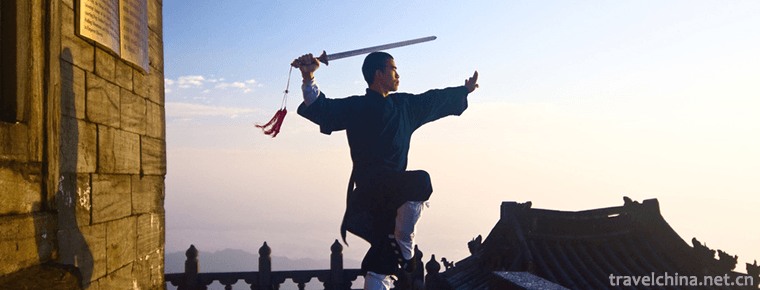
-
Yandang Mountain Scenic Spot
Yandang Mountain, the first batch of national key scenic spots, has the titles of "Sanitary Mountain, Safe Mountain, Civilized Mountain", National Civilized Scenic Spot, National AAAAA Touri.
Views: 190 Time 2018-12-07 -
Longgong Scenic Area of Anshun City
Located in the southern suburb of Anshun City, Longgong Palace is adjacent to Huangguoshu Scenic Area and 116 kilometers away from Guiyang City, the provincial capital..
Views: 129 Time 2018-12-12 -
Yunpu Dongtian Tourist Area
Yimeng Yunpu Cave Tianshan Scenic Area is located in Feixian County, Shandong Province. There are five scenic spots: Tour Stone, Tianmeng Lake, Drunken Stone Forest.
Views: 112 Time 2018-12-22 -
Nanxi Mountain Scenic Area Guilin
Guilin Nanxi Mountain Scenic Area (that is, Guilin Nanxi Mountain Park) is located in the south of Guilin City, about 1 kilometer north of the railway station. The two peaks of Nanxi Mountain confront.
Views: 71 Time 2019-01-13 -
Golden Great Wall Site Park
The Great Wall Site Park is located at the junction of Heimeng and Heilongjiang Province in Nianzishan District, Qiqihar City, Heilongjiang Province. The end of S302 Provincial Highway is the Great Wa.
Views: 198 Time 2019-01-29 -
bir bala
Kazakh is a music-loving nation, known as "horses and songs are the wings of Kazakhstan". Folk songs play a very important role in Kazakh music. Where there is a felt room of Kazakh people, .
Views: 110 Time 2019-05-02 -
Stories of Marine Animals
Marine animal stories are mainly handed down orally. The traditional folklore stories circulated in the islands for a long time have been formed and disseminated in Dongtou.
Views: 274 Time 2019-05-02 -
Xibo embroidery
Xibo embroidery has a long history and rich connotation. Xibo women are skillful and skillful in capturing the beautiful scenery in life. During more than 200 years of living in the western part of th.
Views: 378 Time 2019-07-01 -
Legend of Yang Jiajun
The Legend of Yang Jia Jiang is a kind of literature expressed by folk rap in Northwest China. The story of the generals of the Yangs has a long history. It began to circulate as early as the Song Dyn.
Views: 124 Time 2019-07-11 -
Extra tune
In addition to the form of opera, Yue Diao has two branches, namely, opera and puppet. In 1942, there was a severe drought in Henan Province. During this period, many cross-tone artists (such as Zhang.
Views: 263 Time 2019-07-16 -
Cao Ren
Cao Ren (168 - 23 May 6th), Zi filial piety, Han nationality. Pei country Qiao (today) Anhui Cao Cao, Bozhou From younger brother (from ancestor). The famous heroes of the Three Kingdoms period..
Views: 149 Time 2019-09-15 -
Plant resources in Nanchong
There is only one kind of Metasequoia glyptostroboides introduced and cultivated in Nanchong City; there are two kinds of wild protected plants, namely, fragrant fruit tree and narrow leaf pygmy grass, and two kinds of cultivated Ginkgo biloba and Eucommia.
Views: 356 Time 2020-12-17
